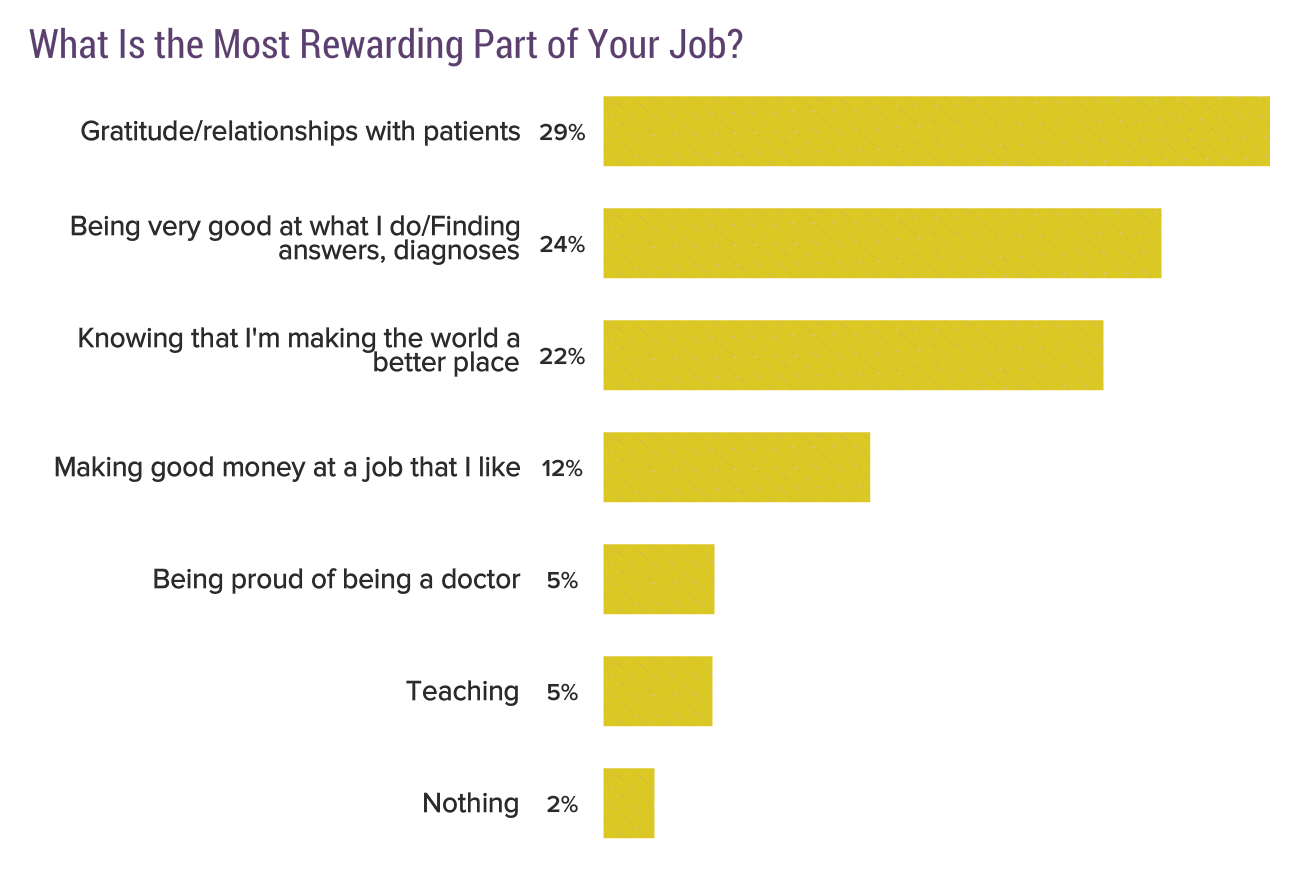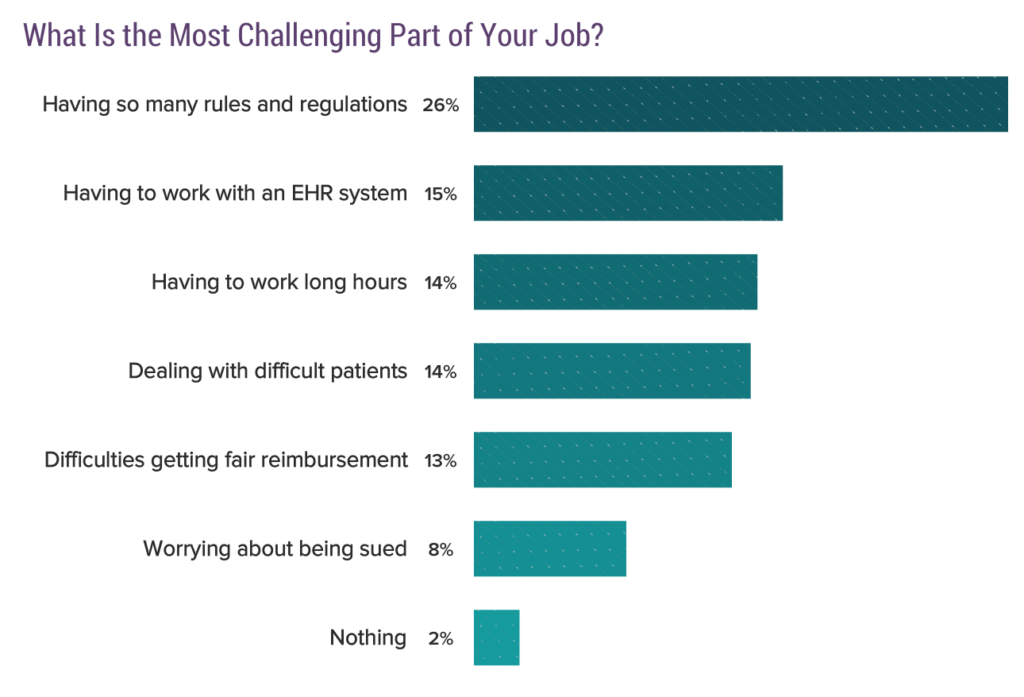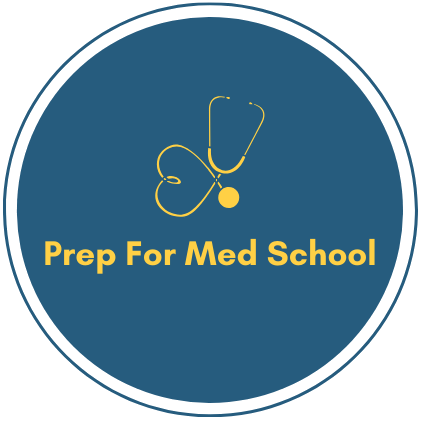Most Rewarding & Challenging Parts of Being a Doctor

Medscape conducted a survey that included 19,328 responding physicians from 30+ specialties. The survey findings were included in their Medscape Physician Compensation Report 2019. Although the report was mostly about compensation and salary, there was also some insight on job satisfaction.
The large dataset gave us valuable data on the rewards and challenges of being a doctor. Here is what the survey found.
Biggest Rewards of Being the Job

1. Gratitude/Relationship with Patients
Gratitude and relationship with patients were the most rewarding part of the job according to 29% of physicians surveyed.
Not surprising that gratitude/relationship with patients is the most rewarding part of the job since being a doctor has long been known as a labor of love. A 2017 American Medical Association (AMA) survey showed that three-quarters of medical students, residents, and physicians said that helping people is a top motivator for pursuing their career.
2/Being Good At The Job and Finding Answers/Diagnosis
Coming in a close second was being good at the job, with 24% of surveyed doctors citing it as the most rewarding part of what they do.
This isn’t surprising since the field draws extremely competitive and competent people. The average undergrad GPA of medical students hovers around the 3.7 to 3.73 range, with a large chunk of classes in BCPM (biology, chemistry, physics, math). The average entrance test score of admitted students is in the 85th percentile. Both of these marks place medical students at the top of all professional degree programs.
The same AMA 2017 survey found that intellectual pursuit was the second biggest motivator for people going into medicine.
3/ Knowing that I’m Making the World a Better Place
Doctors knowing that they are making the world a better place came in third, with 22% of respondents saying that is the most rewarding part.
4/ Making Good Money at a Job I Like
12% of doctors report the most rewarding part of the job is making good money at a job that they like.
Physicians are paid very well for the job they do. According to the Medscape survey, primary care providers earned an average of $237,000 while specialists earned an average of $341,000.
In terms of job satisfaction, a 2017 M3 Global Research survey of 1,150 physicians showed that 76% are either somewhat satisfied or very satisfied with their jobs. This is in line with the decreasing trend of physician burnout.
5-6/ Being Proud of Being a Doctor and Teaching
5% reported being proud of being a doctor was the most rewarding part of the job.
5% also reported that teaching was the most rewarding part of the job.
Biggest Challenges of the Job

1/ Rules and Regulations
Rules and regulations topped the list of the most frustrating part of the job, with 26% of respondents citing it as the main challenge.
According to Geneia’s 2019 Physician Misery Index, 89% of physicians say that business and regulation of healthcare has changed for the worse over time—with 57% strongly agreeing with that sentiment. It is no secret that healthcare in the United States is heavily burdened by government regulations so it is not surprising that this is the number one challenge for many physicians.
2/ Electronic Health Records
Second on the list is having to deal with electronic health records, with 15% of physicians saying that is the most challenging part of the job.
While electronic health records gave health care professionals a standard, quick, and easy way to access and store patient data, the user experience has been less than optimal for many working with them.
3/ Long Hours Worked
Having to work long hours was third on the list, with 14% of doctors saying that is their biggest challenge.
The Medscape survey found the following statistics regarding hours worked among physicians:
| Male | Female | |
| Hours Per Week Spent Seeing Patients: Primary Care | 40 | 36 |
| Hours Per Week Spent Seeing Patients: Specialists | 40 | 37 |
| Male | Female | |
| Hours Per Week Spent On Paperwork and Administration: Primary Care | 16 | 18 |
| Hours Per Week Spent On Paperwork and Administration: Specialists | 15 | 16 |
As seen from the table above, both primary care providers and specialists work close to 60 hours a week.
4/ Dealing with Difficult Patients
Also coming in at 14% was dealing with difficult patients. This number is pretty close to the number of patient-physician encounters that are rated as “difficult”, which is 15%. Although difficult patients can come in many forms, FOJP categorized the 4 main ones as:
The bully. A patient with an abrasive and difficult attitude that starts in the waiting room and carries into the examination room. Someone who challenges the doctor at every turn.
The Internet Expert. A patient who does research on the web and asks a doctor for an alternative course of treatment instead of the reasonable course prescribed.
The Silent-as-a Mouse Patient. The patient is so quiet that it is impossible to obtain an accurate and thorough health history.
The Seeker. A patient who doctor-shopped and presents with extensive testing and charts.
5/ Getting Fair Reimbursement
Difficulty in getting fair reimbursement is next at 13%.
In the Medscape report, physicians used the following models for payment:
| Payment Model | Physicians Using |
| Insurance | 81% |
| Fee-for-service | 44% |
| Accountable Care Organization Participation | 28% |
| Direct Primary Care | 11% |
| Cash-only Practice | 6% |
| Concierge Practice | 2% |
In addition, the following table shows the percentage of doctors participating in MIPS and APMs.
| MIPS | APMs | |
| Primary Care | 42% | 12% |
| Specialists | 37% | 9% |
The landscape for medical reimbursement has changed tremendously in recent years and continues to evolve as alternative payment models gain steam, adding to confusion and frustration. According to the government’s Quality Payment Program, the number of doctors participating in APMs nearly doubled from 2017 to 2018, from 99,076 to 183,306 respectively.
6/ Worried About Being Sued
Lawsuit worries come in last on the list, with 8% of doctors surveyed citing it as their primary challenge.
Although the lawsuits are a very real threat to physicians, the risk is largely mitigated by the large malpractice insurance premiums they have to carry. Medical malpractice insurance varies widely by specialty and locality. But on average, malpractice insurance premiums work out to be about 3.2% of most physicians’ incomes.
References:
https://www.trustedchoice.com/professional-liability-insurance/medical-malpractice/
https://hicgroup.com/sites/default/files/inFocus%20Spring09.pdf
https://www.medscape.com/slideshow/2019-lifestyle-burnout-depression-6011056
https://www.aamc.org/system/files/2019-12/2019_FACTS_Table_B-10.p

Leave a Reply